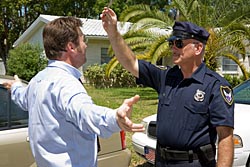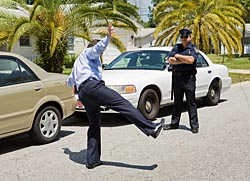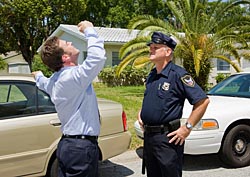If you are ever pulled over by an officer who suspects you are under the influence of alcohol, you may be asked to perform one or more drunk driving field sobriety tests. Designed to detect signs of impairment, these tests use a series of seemingly simple exercises to determine your level of impairment. However, due to their subjectivity, the results of these tests are not always reliable—and countless drivers are incorrectly identified as impaired as a result.
There are three types of field sobriety tests that have been approved by the National Highway Traffic and Safety Administration (NHTSA); they are the one-leg stand, walk and turn, and horizontal nystagmus test. Although each test is designed differently, the purpose of each is to evaluate certain skills that are needed to operate a vehicle safely.
Field sobriety tests (FST) are in no way a scientific method of determining intoxication. Conducting multiple tests and administering them correctly greatly increases the chances of reliability. They are still by no means 100% accurate. Each test is riddled with its own imperfections. There are three recognized field sobriety tests; walk and turn, stand on one leg, and horizontal gaze nystagmus (HGN).
All of the tests expect a level of physical health that many drivers do not comprise. They share that common weakness, but for different reasons. Let’s examine each test and fully understand their strengths and weaknesses.
Horizontal Gaze Nystagmus
Contents
 This test requires the suspect to stare at an object (often the police officer’s pen). The object is moved back and forth while the officer detects a lack of smooth pursuit in the driver’s eyes. In other words, the eyes don’t move smoothly. While it is true alcohol and other illegal substances cause this occurrence, it’s also caused by an onslaught of other conditions. Multiple sclerosis, stoke, natural occurrence, and sedatives are all known causes of nystagmus, which is nothing more than an involuntary jerking of the eyes.
This test requires the suspect to stare at an object (often the police officer’s pen). The object is moved back and forth while the officer detects a lack of smooth pursuit in the driver’s eyes. In other words, the eyes don’t move smoothly. While it is true alcohol and other illegal substances cause this occurrence, it’s also caused by an onslaught of other conditions. Multiple sclerosis, stoke, natural occurrence, and sedatives are all known causes of nystagmus, which is nothing more than an involuntary jerking of the eyes.
- Lack of smooth pursuit (eye cannot smoothly follow stimulus).
- Sustained and distinct nystagmus at maximum deviation (nystagmus longer than 4 seconds when eye is moved furthest from center (approximately 60 degrees)).
- Onset of nystagmus before eye reaches 45 degrees.
The presence of four or more clues is considered a failure of the test. The circumstances of a roadside administration, or a lack of training for the officer administering the test, can significantly affect and/or invalidate test results.
The HGN test is arguable the most accurate with regard to determining an excess level of blood alcohol content (BAC). The others are approximately only accurate just over half the time. The probability of accuracy increases with the number of tests given. FSTs are one tool for law enforcement to detect intoxication. Used alone they are highly ineffective and easy for a strong defense attorney to poke holes through. So do the smart thing and contact a qualified lawyer in your state toda
DUI One Leg Stand Test
 The one-leg stand and walk and turn tests, for example, test balance and coordination, while the horizontal nystagmus test evaluates your vision by looking for an involuntary eye jerking known as nystagmus. During the course of this test, the officer will place a small object (usually a pen or flashlight) directly in front of your face and move it from side to side. If the officer observes a distinct jerking of the eyes, or you are unable to follow the object smoothly, you may be deemed impaired.
The one-leg stand and walk and turn tests, for example, test balance and coordination, while the horizontal nystagmus test evaluates your vision by looking for an involuntary eye jerking known as nystagmus. During the course of this test, the officer will place a small object (usually a pen or flashlight) directly in front of your face and move it from side to side. If the officer observes a distinct jerking of the eyes, or you are unable to follow the object smoothly, you may be deemed impaired.
To perform a one-leg stand test, you must stand in place and count out loud for 30 seconds while one foot is raised approximately six inches off the ground.
The officer looks for four clues of impairment, specifically if the subject being tested:
- Puts the raised foot down.
- Uses arms to balance (raises more than 6 inches from side).
- Sways.
- Hops.
DUI Walk & Turn Test
 Perhaps the most well-known DUI field sobriety test administered by law enforcement is the walk and turn test. Suspects must walk in a straight line, heel to toe, for 9 steps. The police officer will then ask the person to turn and walk back in the same manner. The line may be “imaginary” or often the white line on the highway. The walk and turn test, on the other hand, requires walking an imaginary straight line—taking nine steps forward with your feet placed heel to toe, and then pivoting to return to your original starting point. If you are unable to perform either of these tests without swaying or hopping, the officer may then administer a breathalyzer or other chemical test in order to determine your blood alcohol content (BAC).
Perhaps the most well-known DUI field sobriety test administered by law enforcement is the walk and turn test. Suspects must walk in a straight line, heel to toe, for 9 steps. The police officer will then ask the person to turn and walk back in the same manner. The line may be “imaginary” or often the white line on the highway. The walk and turn test, on the other hand, requires walking an imaginary straight line—taking nine steps forward with your feet placed heel to toe, and then pivoting to return to your original starting point. If you are unable to perform either of these tests without swaying or hopping, the officer may then administer a breathalyzer or other chemical test in order to determine your blood alcohol content (BAC).
The officer looks for eight clues of impairment, specifically, if the subject being tested:
- Cannot keep balance while listening to officer’s instructions.
- Begins before instructions are finished.
- Stops walking.
- Breaks the heel-to-toe walk by more than ½ inch.
- Steps offline.
- Raises arms more than 6 inches from side of body.
- Improper turn.
- Takes an incorrect number of steps.
How do I know if the Test was Administered Properly?
First, the police officer must give clear and accurate instructions. They may also demonstrate the act. The suspect must also understand the instructions by responding to the officer’s requests. Without that, how can you correctly grade someone on a test they may not understand? Many times, language barriers are a cause for mistakes.
What Conditions Cause Test Failure?
Other than intoxication, you may fail the walk and turn test from these conditions:
• Excess weight/obesity
• Over 65 years of age
• Awkward shoes
• Any physical condition affecting balance
• Limited site in one eye
Remember that field sobriety tests such as the Walk & Turn are not generally accepted by the scientific community as an accurate method to measure the quantity of alcohol in one’s blood or to prove the alleged state of intoxication.
In every area of the United States, it is against the law to drive with a BAC of 0.08% or higher. Therefore, if you perform a breathalyzer or other chemical test (blood or urine test), you can expect to be arrested and charged with drunk driving. Fortunately, there are many ways to challenge your field sobriety and chemical test results—but you must have help from an experienced DUI defense attorney to do so.
If you have been charged with driving under the influence, put the odds in your favor—discuss your case with an experienced DUI defense attorney immediately after your arrest. While many law firms may claim to have what it takes to handle your case, it is best to have an attorney who practices DUI law exclusively.
Unlike attorneys who cover a broad range of legal areas, a DUI defense attorney has specialized knowledge in areas such as blood alcohol content (BAC) and chemical tests—and this knowledge can significantly improve your chances of obtaining a successful outcome in DUI court.
Other Sobriety Tests:
Counting
The suspect is asked to count forwards or backwards, usually by ones or threes.
Signs of impairment include:
- skipping letters
- loss of concentration
- slurred speech
This is not a particularly accurate or reliable sobriety test.
Finger to Nose
The subject stands, usually with the head tilted back and eyes closed, with arms stretched out to his sides. The subject then attempts to touch the tip of his index finger to his nose, first with one arm and then the other.
Signs of impairment include:
- Beginning before instructions are completed
- Swaying or staggering
- Using arms to balance
- Losing balance
- Inability to touch fingertip to nose
This test can be difficult to perform even when sober, without practice.
Reciting the Alphabet
The suspect is asked to recite the alphabet, sometimes backwards.
Signs of impairment include:
- Skipping letters
- Loss of concentration
- Slurred speech
This test is not particularly accurate, and may not be appropriate for suspects for whom English is not the primary language.
Chemical Testing Techniques
Despite all evidence to the contrary, if the officer decides a chemical test is justified you typically have three choices of test procedures: Breathalyzer, urine test, or blood test. Frequently, the police will use a Breathalyzer test for the initial screening. However, you are generally allowed the option of taking one of the other two tests, at your request.
The Breathalyzer is the most inaccurate means of measuring your BAC. If the Breathalyzer generates a reading that confirms your BAC is within legal limits, you should be free to leave.
Submit your information online today to locate a DUI defense attorney in your area and receive a free, no-obligation evaluation of your case.